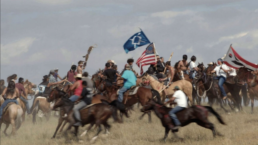Lakota Nation vs. The United States
In Lakota Nation vs. The United States, new light is shed on the fight to regain their sacred land and live in peace once again.
The Black Hills are a magnificent natural wonder that tower over the grasslands of Keystone, South Dakota. Many nationals and tourists alike make the pilgrimage to this remote area to admire one of the country’s most notable monuments: Mount Rushmore. To many, the faces of Theodore Roosevelt, Abraham Lincoln, Thomas Jefferson, and George Washington etched into the mountainside stand as a symbol of freedom, opportunity, and the American Dream. For the Lakota people, however, it serves as a constant reminder of colonialism, genocide, and broken promises.
In filmmakers Jesse Short Bull and Laura Tomaselli’s timely documentary, Lakota Nation vs. The United States, new light is shed on the Lakota people’s fight to regain their sacred land and live in peace once again. Using stunning archival footage from some of America’s earliest days, we bear witness to what led to the unconstitutional takeover of the Black Hills, and gain a deeper understanding of how unfairly the government continues to treat the first inhabitants of the United States of America.
While some of what is discussed throughout the film will sound familiar from textbooks, seeing it brought to life through visuals is even more disheartening. The U.S. has dehumanized Native Americans since the first European settlers arrived in 1492, and this sentiment carried over into the early days of the entertainment business. Characterizing “Indians” in cartoons and films like The Searchers, Peter Pan, and countless others, continued to demonstrate the way Hollywood tropes made a mockery of their existence and importance to this country. In the early 1800s, government officials reneged on a treaty that guaranteed Native Americans land ownership and colonized it for themselves. Over the next hundred years, treaties were constantly drafted yet violated almost immediately.
Lakota Nation vs. The United States is built upon powerful interviews with descendants of the Lakota people who share their ancestors’ struggles through stories that have been passed down from generations. It is a sensitive matter handled with the utmost respect by the filmmakers, including co-director Jesse Short Bull whose own great-great-grandfather, Tatanka Ptchela (Short Bull), was an active witness to the conflict between the two nations in the mid and late nineteenth century. Expertly composed shots by cinematographer Kevin Phillips show the depths of beauty and magic within these sweeping landscapes. Composer Raven Chacon – the first Native American to win a Pulitzer Prize for Music – lends a quietly stirring score that amplifies the sacredness of the subject matter.
“Land is Life” for the Sioux Nation, and this is a powerful testament that is repeated by many throughout the film. Without land, there is no identity. Lakota Nation vs. The United States wasn’t made with the intent to start another conflict with the government. Instead, the filmmakers hope that through respect and recognition of wrongdoings, the future of the Black Hills will one day be returned. As of today, the Lakota people continue to push for rights to their ancestral land.
Distributed by IFC Films. Opening at Laemmle Royal on Friday, July 21st.
Morgan Rojas
Certified fresh. For disclosure purposes, Morgan currently runs PR at PRETTYBIRD and Ventureland.



I’ grateful I got the opportunity to see this. Excellent doc, and I hope as well that the Lakota can have the Black Hills back one day. It is rightfully theirs.